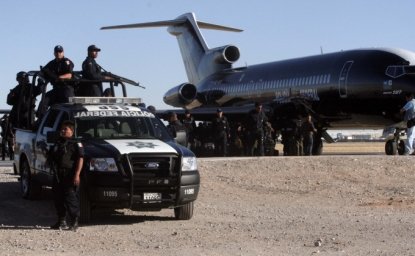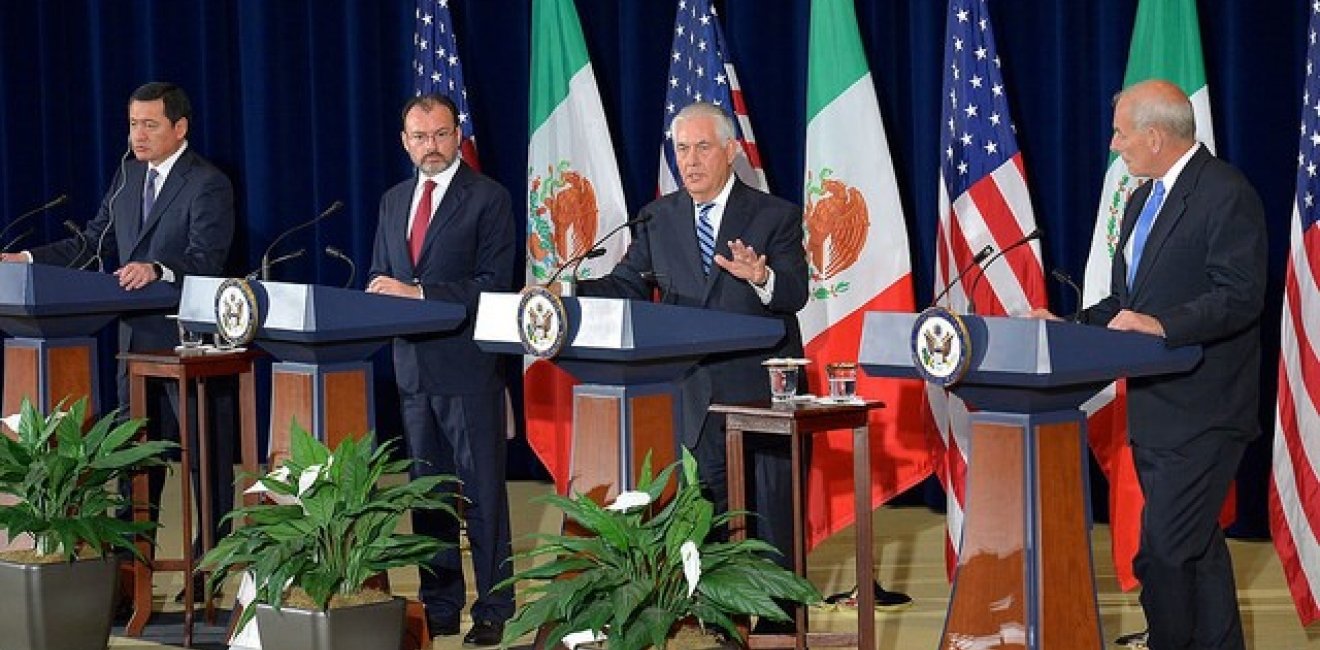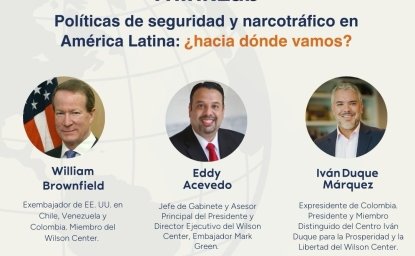Secretary Tillerson Addresses Reporters at a Press Conference With Secretary Kelly and Their Mexican Counterparts in Washington. U.S. Department of State
Mexico and the United States appear to have reached broad agreement on a framework for fighting the organized criminal groups that are responsible for much of the drug trade in the two countries. May 18 meetings between the lead ministers for each government seem to have yielded consensus to take a “fresh” approach to a set of challenges that have vexed both neighbors for decades. The U.S. is facing an epidemic of opioid overdose deaths fueled increasingly by drugs smuggled from Mexico, and Mexico is facing a new surge in violent homicides fueled by criminal groups, many involved in drug smuggling to the U.S. The task ahead is to turn this broad agreement among government ministers into a coherent set of policies and protocols that—if implemented well—will produce improved results against the drug cartels, their production, distribution, financing and arms networks, and the violence which they generate (especially in Mexico), along with improved programs aimed at addressing U.S. demand for drugs. These are big tasks, but the agreement on the analysis of the problem and on a vision for cooperation between the foreign and homeland security cabinet members from both countries is an encouraging step ahead for these two key North American neighbors.
After meeting on the morning of May 18 in Washington, D.C., U.S. Secretary of State Rex Tillerson, U.S. Secretary of Homeland Security John Kelly, Mexican Foreign Secretary Luis Videgaray and Mexican Secretary of Government Miguel Ángel Osorio Chong highlighted a number of important areas of agreement between the governments of Mexico and the United States related to the fight against illegal drugs:
- The ministers signaled a shared focus on destroying criminal organizations that are harming both countries by bringing drugs into the U.S. and by carrying out violence across Mexico. They committed to “build a new shared strategy.”
- They reported that they had identified “fresh strategies to attack the business models” of the criminal organizations with particular emphasis on “cash flow and the flow of weapons.” The emphasis on “fresh” strategies is welcome, as current approaches have not curbed the increased flows of drugs on either side of the border or brought the violence in Mexico under better control. Success will likely require a mix of law enforcement and community-focused programs, some of which will be bilateral and others not.
- The US agreed to work with Mexico to “refocus assistance on better disrupting the business model of the traffickers.” This will likely result in redirecting U.S. funds under the Merida program, as well as refocusing some of the practical cooperation between law enforcement, intelligence and justice agencies.
- Specifically, the U.S. and Mexico agreed to go after “the means of production, their cross-border distribution networks, their cash flow and their weapons procurement.” This means, for example, that the two governments will try to be more effective against opium growing in remote parts of Mexico and the “factories” that turn that opium into heroin or mix heroin with smuggled fentanyl (a powerful synthetic opioid). The statements signal a new willingness by the Mexicans to “work jointly” on all of the elements in the production chain, including to curtail production, where there has been some hesitation to coordinate closely in the past. Similarly, interventions in areas where opium is produced will likely address the needs of local communities with goals of increasing trust in authorities and undermining support or acquiescence to criminal networks.
Figure 1. Illicit Drug Crop Cultivation in Mexico
Source: International Narcotics Control Strategy Report, 2017
- The commitment on cash flow points to the need to find new, more effective ways to track the estimated $19-29 billion from illegal drug sales. A significant portion of these proceeds are believed to make their way back to drug smuggling organizations in Mexico. Despite very serious efforts by U.S. law enforcement, only relatively small amounts of money have been intercepted. Enforcement officers suspect that much of the money is transferred via bulk cash and use of cash-like instruments, via “trade-based” money laundering where the drug proceeds are hidden as legitimate profits from sales of other products, often via a third country, and via other camouflaged channels.
- The U.S. commitment to tackle the purchase of weapons in the U.S. by the drug organizations will be very much appreciated in Mexico. Mexican officials argue regularly that many, if not most, of the weapons used by criminal gangs in Mexico are purchased in the U.S. and smuggled south across the border. On the U.S. side, progress will require strong interagency cooperation. For example, effective efforts to prosecute straw purchases and firearms trafficking schemes can help reduce the arms flows southward, as can increased checks on both sides of the border.
- The U.S. cabinet members committed to addressing the U.S. demand for illicit drugs and stated publically that the U.S. needs to “confront that we are the market” for illicit drugs, as Secretary Tillerson put it. Over the past decade, a number of times, each country would lay the burden of responsibility for drug problems on the other neighbor, but the formulations used by the ministers of both countries last week framed the challenge as a common one where each side needs to address serious aspects of the problem, and the two U.S. cabinet members were clear that demand reduction in the U.S. was a vital part of the work. As Secretary Kelly put it last Thursday, “the most important thing we can do is reduce the drug demand. We’ve never tied it; we’ve never done it. We have to have – develop a comprehensive drug demand reduction program in the United States that involves everybody…” A successful U.S. effort to reduce demand will require strong interagency and federal-state-local cooperation as well as a mix of law enforcement, health and treatment, and public education programs, drawing on the best programs around the U.S. and elsewhere.
Figure 2. U.S. Opioid Crisis
Source: Centers for Disease Control and Prevention, 2017
- Both sides had praise for the Mexican military as well as the police in fighting drug traffickers. Unlike in the U.S., Mexico has had to deploy its armed forces as integral parts of the struggle against organized crime.
- The ministers also talked about the importance of judicial cooperation, and the U.S. expressed support for Mexico going ahead with a draft law which would allow seizure of property and assets of those charged with illicit drug trade.
- Border cooperation was cited as an important area of work in this effort. The “vast majority of hard drugs” are smuggled into the U.S. in vehicles, Secretary Kelly said, “particularly in commercial trucks” and often without the knowledge of the driver. He noted that this problem is being tackled along with Mexican counterparts, but that there is “no one single solution” to cross border smuggling, mentioning physical barriers, technology, patrolling, and police actions as necessary tools for disrupting the illicit drug trade. Nevertheless, as most of the hard drugs seem to come into the U.S. via formal border crossing points, it would seem that investing in better facilities and more trained personnel to check the cross border traffic by both governments would help address the smuggling, while increasing border efficiency.
Secretary Tillerson acknowledged that the Mexican and U.S. teams had “very open, very frank and very candid conversations” about past obstacles and expressed “a very strong commitment” to overcoming them. Clearly, the pathway ahead will be long and difficult. The governments face agile, innovative, brutal and well-resourced opponents in these criminal groups who have spent decades outsmarting, corrupting and killing law enforcement and judicial officials, as well as others, who get in their way.
The U.S. and Mexican teams will need to build between them the additional trust and teamwork required to reach a new level of bilateral cooperation and effectiveness. But, a cooperative spirit and shared vision were on display after last week’s talks. Mexican Foreign Minister Videgaray talked about overcoming “the blame game and the finger-pointing,” and Homeland Security Secretary Kelly highlighted that the two sides would continue to attack the cartels and to deepen and broaden the effort, “with some very, very innovative new ideas”. And, importantly, they put these talks in the wider context of relations between the two neighbors. As Secretary of State Tillerson said, the ministers’ remarks demonstrated that “there are a broad range of issues of great importance and common concern between the United States and Mexico” -- a good message for the journey ahead.
Authors

Former Career Ambassador to Afghanistan, Argentina, and Mexico; Distinguished Diplomat in Residence, School of International Service, American University

Director of Policy and Strategic Initiatives, Seattle International Foundation

Mexico Institute
The Mexico Institute seeks to improve understanding, communication, and cooperation between Mexico and the United States by promoting original research, encouraging public discussion, and proposing policy options for enhancing the bilateral relationship. A binational Advisory Board, chaired by Luis Téllez and Earl Anthony Wayne, oversees the work of the Mexico Institute. Read more

Explore More
Browse Insights & Analysis
Rethinking U.S.-Mexico Security Strategy

America and Mexico to Tackle Increasing Drug Violence


